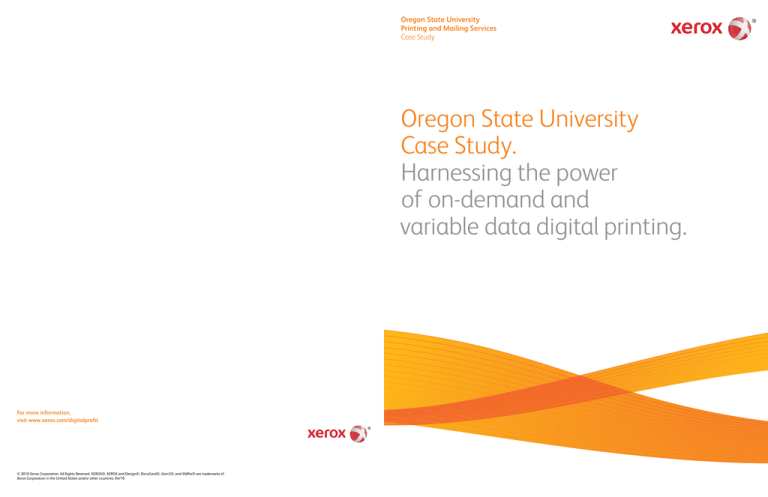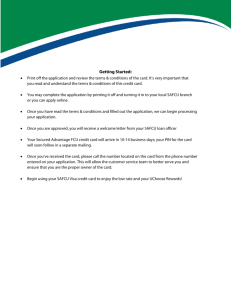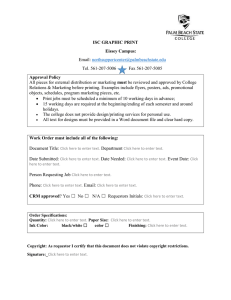
Oregon State University
Printing and Mailing Services
Case Study
Oregon State University
Case Study.
Harnessing the power
of on-demand and
variable data digital printing.
For more information,
visit www.xerox.com/digitalprofit
© 2010 Xerox Corporation. All Rights Reserved. XEROX®, XEROX and Design®, DocuCard®, iGen3®, and XMPie® are trademarks of
Xerox Corporation in the United States and/or other countries. 04/10
Oregon State University makes the most of
its Xerox iGen3 Digital Production Press
and XMPie variable data software.
®
®
®
Oregon State University
Printing and Mailing Services
For more than 140 years, Oregon State
University (OSU) has had a three-fold
mission of teaching, research, and
service to the people of Oregon and
beyond, including via its extension offices
throughout the state. Today, it’s home to
26,000 students, faculty, and staff.
OSU Printing and Mailing Services is
responsible for the myriad of printed
documents used by and produced for
the university’s constituents. These
documents include teaching tools, alumni
communications, admissions recruiting
pieces, budget documents, extension
booklets, and college magazines. It also
prints class packets and does the copyright
search on them.
In addition, about 15% of the department’s
work is done for external customers—
nonprofit organizations and municipalities
that turn to this resource for printing
budget documents, membership cards,
books, and more. This work generates
revenue for the self-supported department.
Challenge
As a self-supporting department, Oregon State University Printing and Mailing Services is used to
handling a variety of jobs for a variety of internal customers. Like similar departments at other higher
education institutions, it also embraces the potential for variable data printing in support of the
university’s goals. And it recognizes the benefits of being able to use an expanded range of media to
suit different needs. The place where the staff doesn’t want to see variety or variability, though, is in
the ability to deliver consistent and accurate color that meets the turnaround needs of customers.
Solution
When it came time to replace its digital printing equipment, the department tested a number of
options from a number of manufacturers. In the end, Printing and Mailing Services selected the
Xerox® iGen3 Digital Production Press for not only its image quality, but also its media latitude, strong
service and support, and integration with XMPie variable data software.
“It’s a powerful combination of equipment and software,” says Cheryl Lyons, associate director
for Printing and Mailing Services at Oregon State University and the manager in charge of the
on-campus location in Corvallis, OR. “The RIP is much faster than what we had before, and the
quality is much better.”
Benefits
In any given month, Printing and Mailing Services produces 100,000 to 200,000 pages on its Xerox®
iGen3 Press. Because it can dependably deliver high-quality digital output, many projects can now be
printed on demand, rather than in larger offset quantities—and digital printing saves on warehousing
costs while enabling more timely content. In addition, variable data printing jobs are enabled through
XMPie to maximize the power of one-to-one communication.
Delivering results with variable data.
A piece critical to the university’s future is one
targeted for prospective students—and it’s
made even more effective through Printing and
Mailing Services’ use of variable data printing.
Originally outsourced to an off-campus iGen3,
this piece is now printed on the in-house iGen3
using XMPie. Text and images are customized to
each prospective student’s test scores, academic
interests, extracurricular activities, and even
geographic location. “It’s a nice piece that
has done well for the university,” says Lyons.
“Admissions are up, and while there are a lot
of factors involved, we believe that this
document has helped.”
In another example of the power of variable
data, the department produces a housing and
dining brochure, which is sent to students who
will be living on campus. It features a photo
of their dorm on the cover, lists each student’s
mailing address, and provides the names and
email addresses of their roommates and dorm
manager. “We know that students are using this
piece because as soon as we send them out, the
dorm managers start receiving emails,”
says Lyons.
An added bonus: postage savings.
With its in-house digital printing capabilities,
the department can also control timing—and
that can yield savings. The 50,000 prospective
student pieces and 20,000 on-campus housing
pieces that the department prints, for example,
are managed based on their geographic
destination. Those that have further to go are
printed and mailed first. “We’ve saved thousands
of dollars in postage by sending these pieces at
the nonprofit rate rather than first class,”
says Lyons.
Bringing more work in-house.
While the department used to be limited to
runs of up to 1,000 pieces, with its iGen3, it can
handle much more. “We’ve been able to bring
a lot of jobs in-house that we had to send out
before because the run was too long,” says Lyons.
The iGen3 can handle the “glamorous” jobs—
such as the variable pieces for students—as well
as the hardworking day-to-day ones.
The department is also targeting the offset work
it still contracts out. “We really look at those jobs
and try to offer our customers variable data
and digital options,” says Lyons. “We market the
advantages of personalization pretty heavily,
and promote our capabilities.”
Expanding with new applications.
In another effort to generate revenue while
delivering added value, the department has
begun to market and produce customized photo
memory books. An online template makes it easy
for customers to add their photos and order their
books for the holidays, graduation, and more.
“We can’t advertise to the general public,” says
Lyons, “but we have 26,000 people on campus.
And that’s a pretty good audience.”
With its expanded capabilities, Printing and
Mailing Services has also garnered work from
outside customers, helping to financially support
its operation. Among other things, it prints
personalized membership cards for a nationwide
union utilizing Xerox® DocuCard® specialty media.
All told, Printing and Mailing Services is a
$5 million operation. While the department
manages about $1 million in offset
printing each year, the overwhelming
majority of work is produced in-house
exclusively on digital printing equipment.
For its in-house printing, OSU today
depends on its Xerox® iGen3 Digital
Production Press. Three trained iGen3
operators produce up to 200,000 pages
per month.
“The capabilities with our iGen3 are just
wonderful, making it possible for us to
produce more and to do it more quickly.”
Cheryl Lyons
Associate Director,
Printing and Mailing Services,
Oregon State University
2
Oregon State University Case Study
Oregon State University Case Study
3



